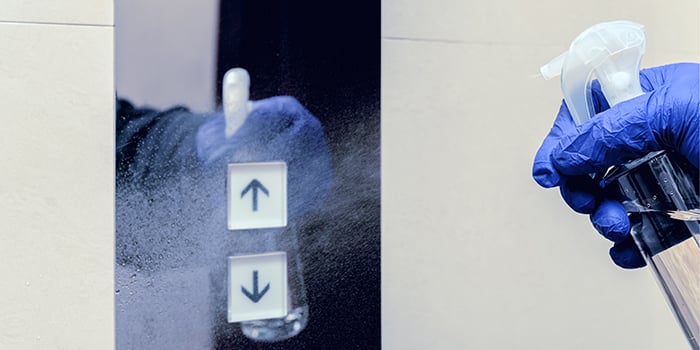
By: WAXIE Editorial Staff | March 19, 2020
In addition to having building occupants and employees practice good hand hygiene, it is also important to maintain a clean and healthy building environment through effective surface cleaning and disinfecting.
It is recommended that your custodial team evaluate and implement measures to minimize the potential transmission of the influenza virus, coronavirus or any other pathogens via hard surfaces through good sound cleaning and disinfecting procedures, with a focus on areas which may have the greatest likelihood of potential environmental contamination such as restrooms, food preparation areas and high touch surfaces.
High touch surfaces in your facility to focus on may include:
• Door handles and knobs
• Light switches
• Hand rails
• Elevator buttons
• Phones
• Sinks and faucets
• Restroom stalls and dispensers
• Vending machines
• Food preparation surfaces
• Breakroom, restaurant and cafe tables and chairs
• Microwave, refrigerator and kitchen appliance handles
• Coffee machines
• Copier, printer and fax control buttons
• Cabinet and file drawer handles
• Hand rails
• Chair arms
• Desks
• Counter tops
• Front desk and lobby surfaces
• Equipment controls
• Wheelchairs and walkers
• Computer keyboards and mouse
• Remote controls
• Recreation equipment

What’s the difference between a cleaner and a disinfectant?
Cleaners are chemical products used to remove soil, dirt, dust, organic matter, and germs. Disinfectants are chemical products that destroy or deactivate germs – disinfectants typically have no effect on dirt, soil or dust.
Disinfectant Guidelines
When using a disinfectant, it is critical to make sure that the proper products have been selected for your building surfaces and anticipated soils, and that your custodial crew has been properly trained on the use of the chemicals, tools and equipment provided. Some helpful tips to consider include:
1. Clean the surface first
Disinfectants primary purpose is to kill microorganisms, and as such they are typically not as good at cleaning surfaces as a general purpose cleaning chemical. While there are some one-step cleaner/disinfectants available, it is necessary to use a general purpose or bioactive cleaner or degreaser to pre-clean heavily soiled areas – and it is helpful to note that using microfiber cleaning cloths and mops also assist to increase the efficacy of the cleaning chemical in removing soils on building surfaces. Cleaning equipment such as the WAXIE VERSA High Performance No-Touch Cleaning Caddies are also extremely effective at removing soils from building surfaces prior to disinfecting.
2. Select the appropriate disinfectant
There are a plethora of disinfectants on the market in a variety of different packages, and it is important to note the listed kill claims on your selected disinfectant so that you can be sure that the product will be effective for the specific circumstances and pathogens in your building. Also take note of compatibility of the disinfectant with your building surfaces – some products are not intended for use on certain surfaces and may either damage surfaces or have decreased efficacy. For emerging viral pathogens the EPA will release disinfectant recommendations on its website, such as List N: Disinfectants for Use Against SARS-CoV-2.
3. Read the disinfectant label instructions
Once the appropriate disinfectant has been selected, follow the instructions listed on the label to ensure proper usage. If the product is a concentrate, make sure to dilute at the recommended amounts, and apply to surfaces as described, using recommended Personal Protective Equipment (PPE).
4. Ensure that the disinfectant has enough surface contact dwell time
Depending on the specific disinfectant and desired pathogen kill, there will be a range of dwell time which will be needed to ensure that the surfaces have been effectively disinfected. Some contact times are as long as 10 minutes (although some are as short as 30 seconds to 1 minute), and it is imperative that the disinfectant solution remain wet and active on the surface for the prescribed amount of time in order to ensure that the targeted pathogens have been successfully eliminated.
5. Train your custodial staff
Disinfectants are designed to kill (they have toxic properties and are listed as pesticides and registered with the EPA), and as such care should be taken when determining the appropriate amount of disinfectant to use, and the appropriate surfaces on which to use it. Focus should be on applying disinfectant to potential high touch surfaces, and staff should be trained on proper dilution, application, recommended Personal Protective Equipment (PPE), surface rinsing, disinfectant chemical disposal and clean up as prescribed on the selected disinfectant label.


